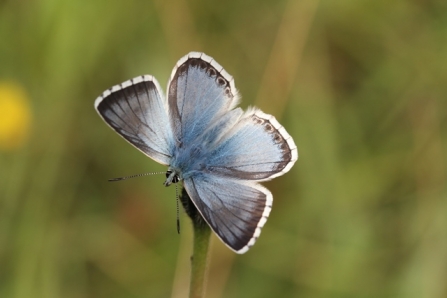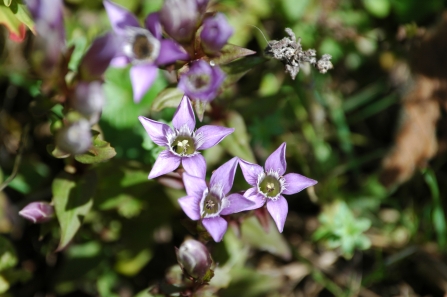
Chalkhill blue by Colin Williams
Protect wildlife for generations to come
Sydlings Copse by Colin Williams

Chalkhill blue by Colin Williams
The Ridgeway National Trail passes through Grangelands. Pause on a walk through the reserve and sit a while on the slopes to enjoy the wonderful views. Watch as common blue, meadow brown and chalkhill blue butterflies flit from flower to flower. The chalkhill blue is limited to chalk grassland as it lays its eggs only on horseshoe vetch, which only grows here.
Common rock-rose is a low-growing, creeping shrub with bright yellow clusters of flowers, which provide plenty of nectar for various bees and is also the foodplant of several species of butterfly including the brown argus.
Look out for other colourful wild flowers, including gentians and harebells. Find out how to tell the difference between Chiltern gentians and the more common autumn gentian in our infographic.

Green tiger beetle by Chris Lawrence
Look out for the emerald flash of a green tiger beetle scuttling along at Padworth Common. This tranquil haven for wildlife includes heathland, woodland and ponds to explore.
Sit near the main pond on North Common and enjoy the darting dragonflies and damselflies. They include the broad-bodied chaser, golden-ringed dragonfly, downy emerald and common hawker.
See if you can catch a glimpse of a grayling butterfly. This heathland specialist is hard to spot as it sits camouflaged on gravelly areas, basking in the sun.

Explore this atmospheric fenland reserve as part of our Cothill Fen Wild Walk. This 5km circular walk takes in two other BBOWT nature reserves, Dry Sandford Pit and Lashford Lane Fen.
Welsh mountain ponies help us look after the fen by grazing here. This stops scrubby bushes taking over, and stops the pools of water drying out.
In August, look out for the graceful grass-of-Parnassus, which produces delicate white flowers on a single stem.

The barrows here are Bronze Age burial mounds. The special, flower-rich grassland is likely to have survived here because the barrows make it physically difficult to plough the land and use for farming.
More than 150 species of plants have been recorded here, including blue harebells and clustered bellflowers. It's also a good place to look for butterflies, including the chalkhill blue, small blue and brown argus.

Sydlings Copse by Colin Williams
Close to Barton on the edge of Oxford, Sydlings Copse is a treasure trove for wildlife enthusiasts with its wide variety of habitats.
There is an area of heathland, a rare habitat for Oxfordshire, which includes patches of gorse that attracts flocks of linnets.
Escape from the heat and wander through the cool, shady woodland then explore the colourful limestone grassland with swathes of wild flowers that attract butterflies and other insects.

Yoesden is one of the best places in Bucks for butterflies. In August, look for a flash of electric blue from the male Adonis blue butterfly. These butterflies fly between mid-May and mid-June and again from early August until mid-September as they have two broods each year.
The caterpillars have an interesting relationship with ants, which are attracted by a sweet secretion, and even a “Siren’s song” produced by the caterpillar. In return the caterpillar is tended and guarded by the ants helping it evade potential predators.
It's also the place to look for Chiltern gentians, purple flowers that only grow in the Chilterns.

Bell heather. Photo by Mark Hamblin / 2020VISION
BBC Countryfile Live by Ric Mellis
Sign up below to receive the latest news from BBOWT, tips about how you can help wildlife, plus information on how you can get involved.